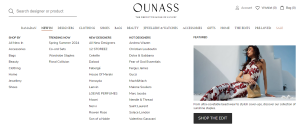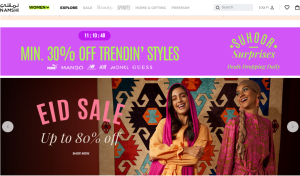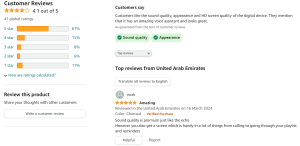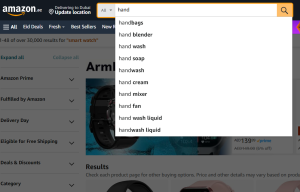Are you planning to start an ecommerce store or looking to upgrade your current one? We’ve got you covered with the top features that every successful ecommerce website should have. From enhancing user experience to boosting sales, these key elements should be incorporated during ecommerce website development.
-
Responsive Design
With responsive ecommerce website design, everything automatically adjusts to fit the screen you’re using. The pictures, layouts, and graphics automatically resize to match your device’s screen. This means you don’t have to pinch, zoom, or scroll sideways just to see the whole website properly no matter whether you are using a desktop, laptop, mobile, tablet, or touchscreen.
There are a few key things that make a website responsive:
- The resolution (screen clarity) automatically adjusts to your device’s screen.
- All images resize themselves to fit your screen nicely.
- The website layout is very flexible and can change its shape to work on any screen size.
- The website works smoothly whether you’re using a touchscreen or cursor/mouse.
By having a fully responsive website development, online shoppers can easily browse and buy things from your store using any device they want – no squinting, pinching, or frustration required!
-
User-friendly Interface
To make visitors happy, everything on your site needs to look nice and be simple. The words, colors, fonts, pictures, and layouts all need to be attractive. This grabs people’s attention when they first see your site and engage them as well. But then, the user-friendly parts like fast loading and easy navigation, keep them engaged.
A truly user-friendly e-commerce website design has three main things:
- It works perfectly on any device – phones, tablets, laptops etc.
- The pages load really quickly on any device.
- It’s very easy to click around and find what you need, no matter what device you’re using.
The search engines like Google also reward user-friendly sites by showing them higher in search results.
-
Intuitive Navigation
When you go to a store, you want to find what you need quickly, right? The same is true for online shopping. An intuitive navigation system helps customers find products easily on your ecommerce website.
All your products should be sorted into logical groups or categories. And the most popular categories should be listed first, at the top. This makes it super simple for customers to start browsing.

A good example is the Ounass website. They have separate sections in their main menu for browsing by designer brand and another for what’s currently trending. They also have quick links to their most popular product categories right on the menu.
-
Footer Navigation
The footer is the bottom part of a website. Many stores are realizing this space can be really handy for helping customers!
Instead of wasting the footer area, you can put links there to your most popular products, important information pages, and services customers frequently need. It’s a great shortcut menu!

Take the Noon ecommerce website. Their footer has tons of useful links organized by category – clothing, electronics, home goods, and more. They also link to their top brands and even their mobile apps.
-
High-Quality Product Images
Having very nice and clear pictures of your products is very important for an ecommerce website. There are a few reasons why:
- First, these days, people like to see pictures more than reading long texts. Our minds can understand pictures much faster than words.
- Second, research shows that websites with good quality pictures get people to share the content more, have fewer product returns, and keep people engaged longer.
- Third, search engines like Google think a website is better if people stay on it longer. So having nice pictures can help your website rank higher in search results.
-
Image/Video Carousels
Many popular ecommerce website designs like Walmart, eBay, and Samsung use carousels on their homepage. A carousel shows a rotating set of images or videos, one after the other.
These carousels are used to showcase the latest products, sales, promotions or collections. The images and videos in the carousel change automatically to show different items.
Some examples are Walmart using a carousel for their top deals, and the fashion site Namshi using one to highlight discounts and new arrivals.

-
Search Engine Optimization
SEO means making your website easy for search engines like Google to find and understand. This is very important for ecommerce sites to get visitors.
Search engines look at many things on your site to decide if it is good and should show up in search results when people look for products you sell.
To have great SEO:
- Use special tools to find the best keywords (words people search for) related to your products.
- Put those keywords in titles, descriptions, and content across your whole site.
- Optimize the home page to tell visitors what your site is about.
- Have a blog section with helpful articles using keywords.
- Use clear product images from multiple angles and describe them properly.
-
Secure Payment Options
When customers buy from your site, you get their private payment details, like credit cards. Ask your ecommerce website development company to keep this information completely safe and secure.
To have a secure payment system:
- Only collect data you actually need, don’t store extra information.
- Let customers checkout as guests without account sign-up if they want.
- Use an SSL certificate to encrypt and protect data moving between your site and servers.
- Use payment processors that have added security layers like Transport Layer Security (TLS).
-
Product Reviews and Ratings
Reviews and ratings from past customers are very important for ecommerce sites. Studies show that 93% of shoppers read reviews before deciding to buy a product.
You should encourage happy customers to leave reviews, both written and video testimonials, on your site. The reviews need to be honest and genuine.
For example, Amazon has reviews shown for every product they sell.

-
Search Functionality
Popular ecommerce platforms make it easy to build custom search capabilities into your site. Major sites like Amazon excel at providing an intuitive search experience.

Having a good search feature on your ecommerce site provides two main benefits:
- It shows you what your customers are looking for by the words they search.
- It makes it faster and easier for customers to find what they want.
To have an effective search, a reputable ecommerce web development company:
- Puts the search box in a prominent place that’s easy to see.
- Uses consistent design, colors, and fonts for all menus so they are recognizable.
- Uses artificial intelligence (AI) to understand what users are searching for and show the most relevant results.
- Optimizes search for both desktop and mobile devices.
-
Visible Call-to-Action Buttons
Every page on your ecommerce site should have clear “call-to-action” buttons. These are special buttons that encourage visitors to take the next step, like “Add to Cart” or “Buy Now“.
The buttons should be easily visible and use persuasive text to get people to make a purchase decision quickly.
You can hire an ecommerce web development company to build your site with effective call-to-action buttons from the start.
-
Product Videos
Adding videos to your product pages can really help increase sales. Over 50% of shoppers say videos assisted them in deciding which product or brand to buy. Most ecommerce website development platforms allow you to upload videos along with photos for each product listing.
A great example is Apple’s website, which uses high-quality video to showcase the latest iPhone’s features in a compelling way.
-
Product and Store Information
The descriptions you write for each product need to be well-crafted and helpful, not generic. Explain the features, benefits, and why it’s the best solution for the customer’s needs.
Also have a Frequently Asked Questions (FAQ) sections to address:
- Common questions buyers have
- General queries like payment, shipping, refunds, privacy etc.
Providing detailed product info and addressing pre-purchase questions builds trust and results in more sales.
-
Order Tracking
After placing an order, the biggest question is “When will my order arrive?” Make it very easy for customers to track their order status on your website.
Ask your ecommerce web development company to create a hassle-free order tracking page.
This allows anxious buyers to instantly check where their purchase is in the shipping process.
Chatbots
An ecommerce website is open for business 24/7. This means you need to provide customer support round-the-clock too. Your ecommerce website development company can help with this.
Many online stores use chatbots to assist shoppers with basic questions anytime. The chatbot can guide customers to specific products or information pages.
Surveys show positive feelings towards chatbots nearly doubled from 2020 to 2021 as they become more helpful.
-
Product Availability Filters
If you offer different pickup or delivery options, allow customers to easily filter products to only show what’s available for their preferred method.
For example, a filter for “Available for Curbside Pickup” or “Get It Delivered Tomorrow“.
-
Personalized Recommendations
The words customers use when searching your site show what they are interested in. Use this data to personalize product recommendations for repeat buyers.
You can email or text them about items they may like based on their past purchases and searches. But you need customers to provide contact details first.
-
Social Media Integration
Having an ecommerce website doesn’t eliminate the need for social media pages. Use platforms like Facebook, Twitter, Instagram to:
- Build awareness of your brand
- Engage potential customers
- Get product reviews
- Drive traffic to your website
- Even directly sell some products
If you are ready to launch or expand your ecommerce business with a high-performing website, connecting with a reputed ecommerce web development company should be your next step.




